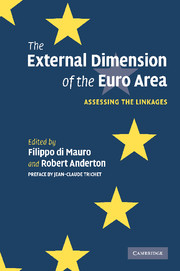Book contents
- Frontmatter
- Contents
- List of illustrations
- List of contributors
- Preface by Jean-Claude Trichet
- 1 Introduction
- 2 The external dimension of the euro area: stylised facts and initial findings
- 3 Product variety and macro trade models: implications for the new EU Member States
- 4 Exchange-rate pass-through to import prices in the euro area
- 5 The international equity holdings of euro area investors
- 6 Global linkages through foreign direct investment
- 7 Shocks and shock absorbers: the international propagation of equity market shocks and the design of appropriate policy responses
- 8 The euro area in the global economy: its sensitivity to the international environment and its influence on global economic developments
- Index
- References
4 - Exchange-rate pass-through to import prices in the euro area
Published online by Cambridge University Press: 22 September 2009
- Frontmatter
- Contents
- List of illustrations
- List of contributors
- Preface by Jean-Claude Trichet
- 1 Introduction
- 2 The external dimension of the euro area: stylised facts and initial findings
- 3 Product variety and macro trade models: implications for the new EU Member States
- 4 Exchange-rate pass-through to import prices in the euro area
- 5 The international equity holdings of euro area investors
- 6 Global linkages through foreign direct investment
- 7 Shocks and shock absorbers: the international propagation of equity market shocks and the design of appropriate policy responses
- 8 The euro area in the global economy: its sensitivity to the international environment and its influence on global economic developments
- Index
- References
Summary
Introduction
While exchange rate pass-through has long been of interest, the focus of this interest has evolved considerably over time. After a long period of debate over the law of one price and convergence across countries, beginning in the late 1980s exchange rate pass-through studies emphasised industrial organisation and the role of segmentation and price discrimination across geographically distinct product markets. More recently, pass-through issues play a central role in debates over appropriate monetary policies, exchange rate regime optimality in general equilibrium models and adjustment scenarios with respect to country external imbalances. These debates have broad implications for the conduct of monetary policy, for macroeconomic stability, international transmission of shocks and efforts to contain large imbalances in trade and international capital flows.
Another issue receiving attention in the recent macroeconomic debate is the stability of exchange rate pass-through rates over time. Taylor (2000), Goldfajn and Werlang (2000), Campa and Goldberg (2005), and Frankel, Parsley and Wei (2005), have argued that pass-through rates may have been declining over time in some countries. The Brazilian experience of the late 1990s is often cited. Here, consumer prices hardly responded to large home currency depreciation, in sharp contrast with past depreciation episodes. Campa and Goldberg (2005) caution against the assumption that pass-through has been declining over time across all OECD countries. While some countries have experienced reduced transmission of exchange rate changes into import prices, much of their measured declines are due to a change in the composition of their import bundle towards goods with lower pass-through elasticities.
- Type
- Chapter
- Information
- The External Dimension of the Euro AreaAssessing the Linkages, pp. 63 - 94Publisher: Cambridge University PressPrint publication year: 2007
References
- 3
- Cited by



